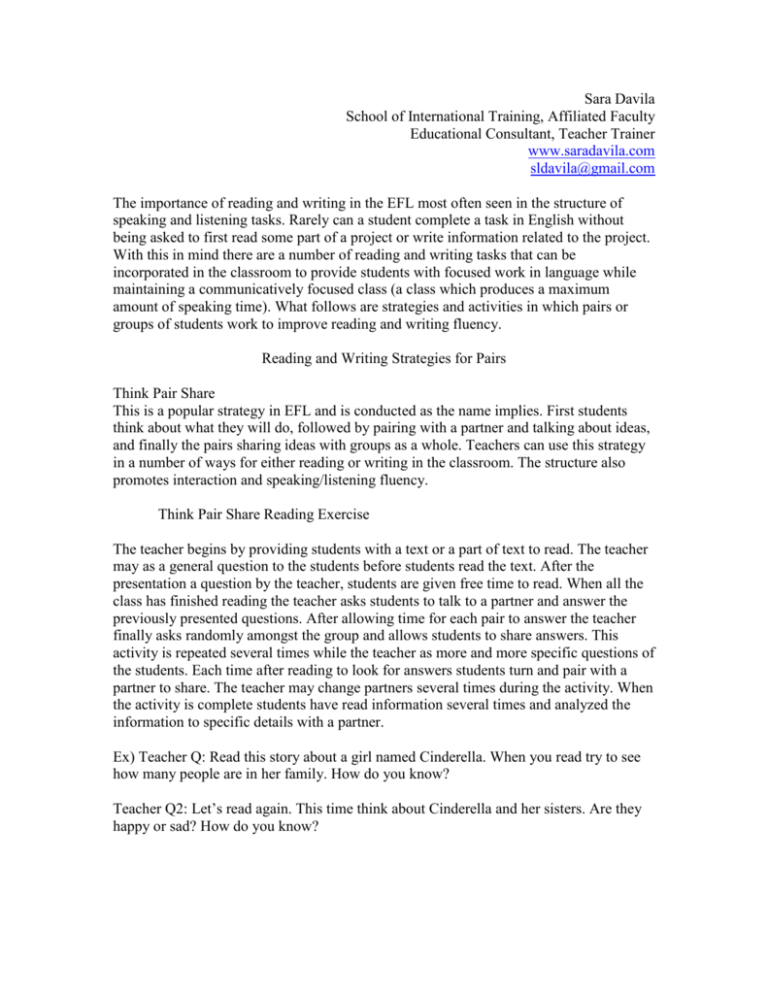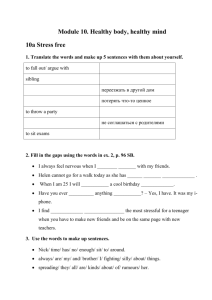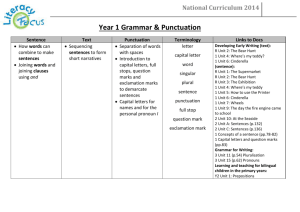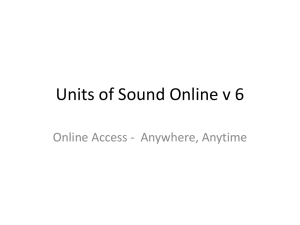The importance of reading and writing in the EFL most often seen in
advertisement

Sara Davila School of International Training, Affiliated Faculty Educational Consultant, Teacher Trainer www.saradavila.com sldavila@gmail.com The importance of reading and writing in the EFL most often seen in the structure of speaking and listening tasks. Rarely can a student complete a task in English without being asked to first read some part of a project or write information related to the project. With this in mind there are a number of reading and writing tasks that can be incorporated in the classroom to provide students with focused work in language while maintaining a communicatively focused class (a class which produces a maximum amount of speaking time). What follows are strategies and activities in which pairs or groups of students work to improve reading and writing fluency. Reading and Writing Strategies for Pairs Think Pair Share This is a popular strategy in EFL and is conducted as the name implies. First students think about what they will do, followed by pairing with a partner and talking about ideas, and finally the pairs sharing ideas with groups as a whole. Teachers can use this strategy in a number of ways for either reading or writing in the classroom. The structure also promotes interaction and speaking/listening fluency. Think Pair Share Reading Exercise The teacher begins by providing students with a text or a part of text to read. The teacher may as a general question to the students before students read the text. After the presentation a question by the teacher, students are given free time to read. When all the class has finished reading the teacher asks students to talk to a partner and answer the previously presented questions. After allowing time for each pair to answer the teacher finally asks randomly amongst the group and allows students to share answers. This activity is repeated several times while the teacher as more and more specific questions of the students. Each time after reading to look for answers students turn and pair with a partner to share. The teacher may change partners several times during the activity. When the activity is complete students have read information several times and analyzed the information to specific details with a partner. Ex) Teacher Q: Read this story about a girl named Cinderella. When you read try to see how many people are in her family. How do you know? Teacher Q2: Let’s read again. This time think about Cinderella and her sisters. Are they happy or sad? How do you know? Teacher Q3: Now read it one more time. This time let’s look for the vocabulary words in the story. Can you find each word? What does frustrated mean in the story? Think about it so we can talk about it with a partner. Teacher Q4: Let’s read the story a final time. When you read think about Cinderella’s situation. What are things she could do to change her life? What would you recommend if you were Cinderella’s friend? Think Pair Share Writing Exercise In a writing exercise the teacher starts with a general theme. First the teacher may ask students to brainstorm some words related to the theme. Each student is given time to make a personal list. Afterwards partners are asked to turn to another student and share the brainstormed list, adding to it any new information. Partners will also check for errors in form, use or meaning. The teacher will then ask students to share the information with a large group. Once the first list has been created teachers provide a new question to further organize the students thoughts from the general list. Students may be asked to sequence the list from first to last to begin organization. Once each student has finished individually, students are again asked to talk with a partner. This continues as teachers ask students to write first short sentence, then longer sentences, until students have completed a paragraph or a paper (this depends on the level of students and writing ability). This use of think pair share again allows for multiple practices with writing while also receiving important input and feedback on errors to improve writing skills. Ex) Teacher Prompt First Writing: Today we are going to write about a birthday party. Make a list of all the words you can think about a birthday party. Teacher Prompt Second Writing: Now that we have some words we can use look at you list. Which words will be good to use, or easy to use. Put them in order from 1 to last. Teacher Prompt Third Writing: This list is really organized now. Let’s write some sentences. Use the order you made for your list. Write a short sentence for each word. Don’t worry about making it long. Teacher Prompt Fourth Writing: Let’s see if we can combine our sentences using and. Can you make longer sentences to make a paragraph? Teacher Prompt Fifth Writing: When you read your sentences one last time does the paragraph make sense to you? Does each sentence work correctly? Can you find any errors? Check it one last time and make any changes you’d like to make. Running Dictation For this activity teams are divided into two partner pair groups. Pairs work together to gather information presented somewhere in the class (usually the wall or hallway), reading appropriate information, and returning to relate the information orally to partners. Information can be a series of sentences, a paragraph, or a story. The activity continues until all the information has been collected. Once collected the running partner copies the information that was collected. As pairs finish the teacher provides a corresponding question sheet which asks for answers collected during the running dictation process. Ex) In the activity students will collect information about different jobs. After reading the students will use the information to assign job titles to different pictures. I Say You Write During this activity students work together to write a story based on a students personal life. The teacher begins by presenting a general question to the students in the pair. One student answer the question while a partner listens and writes, checking correctness by asking comprehension questions (Is this correct? What did you say? Can you repeat that?). Once student A is finished the role is changes to student B can answer the question while student A writes. This continues as the teacher asks several follow up questions to get more information. Finally students’ trade papers and each person will read their personal story making an corrections that may be necessary. Ex) Today we will write a little story about an experience you have had. First answer this question to your partner: Have you ever had a picnic? Listen and write your partners answer, then change. Don’t write your own answer. Q2: Who went with you on the picnic? Q3: Where did you go for your picnic? Q4: What food did you bring? Q5: Where did you get the food? Who made it? Did you make any of it? Q6: What else did you do at the picnic? Play a game? Read a book? Q7: Did you have fun on your picnic? Why or why not? Q9: Would you like to do it again? Why or why not? Reading and Writing Strategies for Large Groups Reading Dictation In a group of three students are divided into two roles, reader and writers. The writers will listen as the reader begins to read a story. Each student takes a turn reading part of the story. The story may be composed of short sentences or paragraphs based on the level of ability of the class. As students listen and write comprehension questions are asked to the reader (Is this correct? What did you say? Can you repeat that). After students have finished reading and writing the selection the originally story is collected and students are asked to answer comprehension check questions using the story written in notebooks. Students share information to fill in any missing pieces while answering all the questions. Chain Stories Students are presented with a general topic in a group of four. The teacher may also give the students the first line to a story. After reading the first line each student takes a turn adding a new sentence to the story. Students continue until they have completed a story. Once each group has finished the teacher asks groups to exchange the stories with another team. The teams then take time to read the story and answer general questions asked by the teacher. Ex) Chain story prompt: Three children are walking in the jungle. General Q’s for finished story: What happened first in the story? Was the story exciting? Why or why not? What happened last in the story? How many characters were in the story? Who was the most interesting character? Why? Did you like the story? Why or why not? Reading Map Provide a group of students with a story. The story may be presented as a reading dictation. After students have completed reading the story the teacher provides each team with a large piece of paper and asks students to map the story from general to specific details. Teams work together to draw or map the story on the large paper showing the various details. Ex) John and tom are going to the story. John needs to buy new shoes for soccer. Tom needs to get a new uniform to play soccer in. They go to the department store. On the first floor they find jewelry. They don’t need earrings. On the second floor they find lots of winter coats and jackets. But it’s summer time. On the third floor they find video games and computers. They played some Xbox soccer before moving on. On the fourth floor they found some nice shoes. John found a great pair of soccer shoes, but Tom was not finished. On the next floor they found women’s clothing. Tom didn’t need that. On the sixth floor their were lots of things for boys and men, but no soccer uniforms. John bought his soccer shoes, but they will have to go a uniform shop to get a uniform for Tom. Ss map the story. D. Store Tom John shoes YES! Reading and writing is extremely important for students studying English. At the same time teachers do not need to worry about losing valuable class time to total silence while students complete a reading or writing activity. By applying some of these interesting and engaging strategies teachers and students alike can experience the fun of improving English dynamically. Additional Resources for Teachers References and Resources Anderman, L. H. (2004, Jul/Aug). Student Motivation Across Subject-Area Domains. Journal of Educational Research, 97(6), 283. Cantor & Associates (Producers), & . (2004). Self-Directed Learners [Motion Picture]. USA: Canter. Costa , A. L., & Kallick, B. (2001). Activating and engaging habits of the mind. Alexandria, VA: Association for Supervision and Curriculum Development. ESL Standards for PreK-12 Students. (1997). Bloomington, IL: Pantagraph Printing. Johnson, D. W., & Johnson, R. J. (2001). Cooperative Learning And Social Interdependence Theory. Retrieved February 5, 2005, from http://www.co-operation.org/pages/SIT.html Kagan, S. (1995, 5). We can talk: Cooperative learning in the elementary ESL classroom. Education Resources Information Center. Retrieved 7 1, 2005, from http://www.ericdigests.org/1996-1/talk.htm Overview of Selected Cooperative Learning Structures. (2003). Retrieved February 5, 2005, from http://www.literacynet.org/icans/chapter01/overview.html Paul, R. W. (1991). Teaching critical thinking in the strong sense. Association for Supervision and Curriculum Development, pp. 77-84. Silver, H. F., Strong , W. R., & Perini, J. M. (2000). So each may learn: Integrating learning styles and multiple intelligences. Alexandria, VA: Association for Supervision and Curriculum Development. Silver, H. F., Strong, R. W., Hanson, J. R., & Schwartz, P. B. (1980). Teaching styles and strategies: Interventions to enrich instructional decision-making (3rd ed.). Trenton, NJ: The Thoughtful Education Press. Valentine, D. P., & Freeman, M. (2000, April 1). Application Cards: A Classroom Technique for Teaching Social Work Practice. Social Work Education, 19(2), 155-164.







